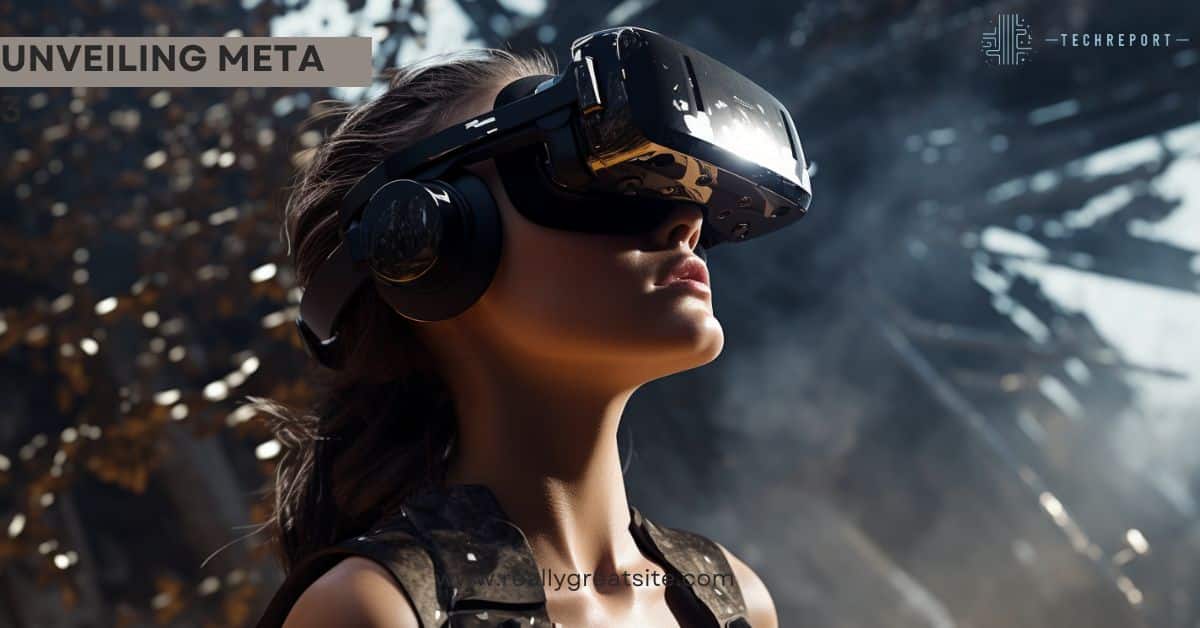Step into the future of virtual reality with the unveiling of Meta 3 in September 2023. Developed by Meta Platforms, this state-of-the-art headset redefines the VR experience.
Building on the success of its predecessor, the Meta 3 introduces a range of enhancements. From an upgraded display to the powerful Snapdragon XR2 Gen 2 processor, each improvement is crafted to elevate the virtual reality experience. This review explores the advancements that position Meta 3 as a leader in the evolving landscape of VR technology.
Also Read: How to Transfer Apple Cash to Bank
Meta Quest 3 Features

Higher-Resolution Display
Dive into a visual feast with Meta 3’s 4K+ Infinite Display, boasting 25PPD and 1218 PPI. This nearly 30% leap in resolution from Quest 2 ensures a sharper and more detailed visual experience, setting a new standard in VR clarity.
More Powerful Snapdragon XR2 Gen 2 Processor
Experience seamless performance powered by the Qualcomm Snapdragon XR2 Gen 2 processor. Twice as potent as its predecessor, the XR2 Gen 2 ensures smoother gameplay, reduced frame drops, and an overall heightened virtual reality encounter.
Improved TruTouch Haptics
Elevate your sense of touch with Meta 3’s new TruTouch haptics. These enhancements provide a more realistic feedback during gameplay, making each interaction within the virtual environment more immersive and engaging.
Slimmer Design for Enhanced Comfort
Redefining comfort, the Meta 3 features a 40% slimmer design compared to Quest 2. With a streamlined and more ergonomic form factor, wearing the headset for extended periods becomes more comfortable, ensuring an immersive experience without compromise.
Specifications Comparison with Quest 2

Delving into the visual realm, Meta 3’s 4K+ Infinite Display outshines Quest 2’s 2K+ display. With 25PPD and 1218 PPI, Meta 3 offers a significant leap in resolution, providing sharper graphics and a more immersive visual experience.
Meta 3’s powerhouse lies in the Qualcomm Snapdragon XR2 Gen 2 processor, a substantial upgrade from Quest 2’s XR2. Coupled with 8GB of RAM, Meta 3 ensures snappier performance, faster boot times, and an overall smoother VR experience.
Meta 3 offers flexible storage choices with 128GB and 512GB variants, outshining Quest 2’s 64GB and 256GB options. Additionally, the Touch Plus controllers with wrist straps and TruTouch haptics add a new dimension to user interaction, enhancing overall gameplay.
Elevating the auditory experience, Meta 3 introduces rich 3D audio with enhanced sound clarity and bass performance. Compared to Quest 2’s integrated speakers and microphone, Meta 3’s audio enhancements provide a more immersive and engaging virtual soundscape.
Also Read: How to Unmute Posts on Instagram
Pricing and Availability
Meta Quest 3 Pricing Details
The Meta Quest 3 is competitively priced, starting at $499.99 for the 128GB model. For those seeking extended storage, the 512GB variant is available at $649.99. This pricing positions Meta 3 as a valuable investment for enthusiasts looking to elevate their virtual reality experiences.
Available Models and Storage Options
Meta Quest 3 caters to diverse user needs with two storage options: 128GB and 512GB. Whether you opt for ample storage for your VR content or a more budget-friendly option, Meta 3 ensures flexibility to suit varying preferences.
Purchase Information from the Official Meta Website
To acquire the Meta Quest 3 and unlock the next level of virtual reality, head to the official Meta website. The Meta website serves as the exclusive platform for securing your Meta 3 headset, offering a direct and secure purchasing avenue for VR enthusiasts.
Meta Quest 3 Review

Meta’s latest offering, the Quest 3, earns acclaim for its substantial improvements over its predecessors. From enhanced comfort to a more powerful processor, the Quest 3 stands out as a commendable advancement in the realm of virtual reality. Users can expect an overall positive and satisfying experience with this upgraded headset.
The Meta Quest 3 surpasses the Quest 2 in various aspects, establishing itself as a superior successor. Notable upgrades include a higher-resolution display, a more potent Snapdragon XR2 Gen 2 processor, and improved TruTouch haptics. The Quest 3 outshines its predecessor in performance, comfort, and overall user satisfaction.
The Quest 3 introduces significant improvements that contribute to an enhanced user experience. From a slimmer design for prolonged comfort to a sharper display, users can delve into virtual realms with unprecedented clarity. The improved passthrough feature adds convenience, allowing users to navigate their physical space seamlessly while wearing the headset.
Also Read: Apple AirDrop Guide
Mixed Reality Potential
Meta envisions the Quest 3 as more than just a VR headset; it aims to pioneer mainstream mixed reality experiences. With a strategic focus on blending the digital and real worlds seamlessly, Meta positions the Quest 3 as a crucial step towards a future where mixed reality becomes an integral part of our daily lives.
The Quest 3 introduces mixed reality features, marking a significant leap in technology. The enhanced passthrough, enabled by the front-facing cameras, provides users with a clearer view of their physical surroundings. This feature not only contributes to improved comfort but also sets the stage for mixed reality experiences by seamlessly merging the virtual and real worlds.
Despite the promising mixed reality capabilities, the Quest 3 currently faces a content gap. While the improved passthrough offers practical benefits, the available mixed reality content is limited. First Encounters, a notable mini-game, showcases the potential of mixed reality, but the overall selection remains modest. Developers need to tap into this technology to create a diverse range of applications and experiences to fully unlock the mixed reality potential of the Quest 3.
In Crux
In summary, the Meta Quest 3 emerges as a commendable advancement in the realm of virtual reality. Its strengths lie in a higher-resolution display, a powerful Snapdragon XR2 Gen 2 processor, and a slimmer design for extended comfort. The improved passthrough and mixed reality features contribute to an overall positive user experience.
Positioned as the successor to the Quest 2, the Meta Quest 3 offers substantial improvements, but its position in the market comes with a nuanced perspective. While the device excels as a VR headset, the mixed reality features hint at a future direction. However, its success hinges on the evolution of content and societal acceptance of mixed reality devices.
Looking ahead, the Meta Quest 3 sets the stage for potential developments in mixed reality technology. As Meta continues to iterate on its vision, future expectations include a more robust ecosystem of mixed reality applications, addressing the current limitations and making mixed reality a more mainstream and compelling experience.
How much did you like Our Detailed Unveiling Meta 3: A Virtual Reality Revolution? Review Also, please share these Blogs with your friends on social media.
Related Blogs
- Is iPhone 14 Worth the Hype
- Unblock Banned Apps
- Best Cheap VPN Services
- Curved or Flat: Which TV Should You Buy?
- Samsung S23 vs Pixel 7
FAQs about Meta 3
What sets the Meta Quest 3 apart in terms of mixed reality?
The Meta Quest 3 distinguishes itself by introducing mixed reality features through enhanced passthrough capabilities. With clearer views of the physical surroundings, the device lays the groundwork for immersive mixed reality experiences, aligning with Meta's vision of seamlessly blending the digital and real worlds.
How does the Meta Quest 3 address comfort concerns during extended use?
The Meta Quest 3 addresses comfort concerns by adopting a slimmer design and improved weight distribution. Users will find the headset more comfortable for prolonged periods, and the addition of an optional $70 Elite Strap further enhances the overall wearing experience.
What is the pricing range for the Meta Quest 3, and where can it be purchased?
The Meta Quest 3 is competitively priced, starting at $499.99 for the 128GB model and $649.99 for the 512GB variant. To make a purchase, users can conveniently visit the official Meta website, the exclusive platform for securing this cutting-edge virtual reality headset.
Is there enough mixed reality content available for the Meta Quest 3?
While the Meta Quest 3 showcases promising mixed reality capabilities, the current content landscape is somewhat limited. First Encounters, a mini-game, exemplifies the potential, but developers need to contribute more varied applications to fully exploit the mixed reality potential of the device.
























